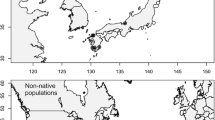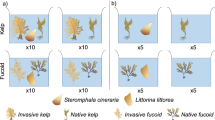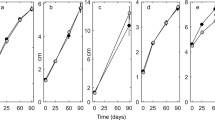Abstract
Numerous hypotheses have been posited to explain the observed variation in plant defense strategies against herbivory. Under resource-rich environments, plants are predicted to increase their tolerance (limiting resource model; LRM) and, while the resource availability hypothesis (RAH) predicts a decrease in constitutive resistance in plant species growing in resource-rich environments, at the intraspecific level, plants are predicted to follow an opposite pattern (intraspecific RAH). Furthermore, the effect of multiple factors in modulating plant defense strategies has been scarcely explored and is more difficult to predict. Our aim was to understand how plant defense traits respond to herbivory, resource availability and their interactions, and to assess the effects on plant palatability. To this end, we performed an in situ factorial experiment at two sites simulating three herbivory levels and two nutrient availability conditions with the seagrass Posidonia oceanica. Additionally, we performed a series of feeding experiments with its two main herbivores. While plants decreased their constitutive resistance under nutrient fertilization (contrary to intraspecific RAH but in accordance to the RAH), and did not increase allocation to tolerance (likely due to resource limitation, LRM), simulated herbivory induced resistance traits. However, we found no interactive effects of nutrient fertilization and herbivory simulation on plant defense. Both herbivores responded similarly to changes in plant palatability, strongly preferring nutrient-enriched plants and non-clipped plants. This work highlights the need to better understand the drivers of plant defense intraspecific variability in response to resources, particularly in habitat-forming species where changes in plant traits and abundance will cascade onto associated species.



Similar content being viewed by others
References
Agrawal AA (2011) Current trends in the evolutionary ecology of plant defence. Funct Ecol 25:420–432. https://doi.org/10.1111/j.1365-2435.2010.01796.x
Agrawal AA, Karban R (1999) Why induced defenses may be favored over constitutive strategies in plants. In: Tollrian R, Harwell CD (eds) The ecology and evolution of inducible defenses. Princeton University Press, Princeton, pp 45–61
Alcoverro T, Duarte CM, Romero J (1995) Annual growth dynamics of Posidonia oceanica: contribution of large-scale versus local factors to seasonality. Mar Ecol Prog Ser 120:203–210. https://doi.org/10.3354/meps120203
Alcoverro T, Manzanera M, Romero J (2000) Nutrient mass balance of the seagrass Posidonia oceanica: the importance of nutrient retranslocation. Mar Ecol Prog Ser 194:13–21. https://doi.org/10.3354/meps194013
Arjonilla M, Forja JM, Gómez-Parra A (1991) Efecto de la materia en suspensión en el análisis de nutrientes con un analizador de flujo continuo de tercera generación. Sem Quim Mar 5:112–120
Bazzaz FA, Chiariello NR, Coley PD, Pitelka LF (1987) Allocating resources to reproduction and defense. Bioscience 37:58–67. https://doi.org/10.2307/1310178
Bloom AJ, Chapin FS, Mooney HA (1985) Plants-an economic analogy. Annu Rev Ecol Syst 16:363–392
Borowitzka MA, Lavery P, van Keulen M (2006) Epiphytes of seagrasses. In: Larkum A, Orth RJ, Dua (eds) Seagrasses: biology, ecology and conservation, Springer, New York, pp 441–461
Burnham KP, Anderson DR (2002) Model selection and multimodel inference: a practical information-theoretic approach, 2nd edn. Springer, New York
Carmona D, Fornoni J (2013) Herbivores can select for mixed defensive strategies in plants. New Phytol 197:576–585. https://doi.org/10.1111/nph.12023
Carr LA, Bruno JF (2013) Warming increases the top-down effects and metabolism of a subtidal herbivore. PeerJ 1:1–15. https://doi.org/10.7717/peerj.109
Cebrian J (1999) Patterns in the fate of production in plant communities. Am Nat 154:449–468. https://doi.org/10.1086/303244
Cronin G, Hay ME (1996) Within-plant variation in seaweed palatability and chemical defenses: optimal defense theory versus the growth-differentiation balance hypothesis. Oecologia 105:361–368. https://doi.org/10.1007/BF00328739
De Bruyn L, Scheirs J, Verhagen R (2002) Nutrient stress, host plant quality and herbivore performance of a leaf-mining fly on grass. Oecologia 130:594–599. https://doi.org/10.1007/s00442-001-0840-1
de los Santos CB, Brun FG, Onoda Y et al (2012) Leaf-fracture properties correlated with nutritional traits in nine Australian seagrass species: implications for susceptibility to herbivory. Mar Ecol Prog Ser 458:89–102. https://doi.org/10.3354/meps09757
Delphia CM, Mescher MC, De Moraes CM (2007) Induction of plant volatiles by herbivores with different feeding habits and the effects of induced defenses on host-plant selection by thrips. J Chem Ecol 33:997–1012. https://doi.org/10.1007/s10886-007-9273-6
Dostálek T, Rokaya MB, Maršík P, Rezek J (2016) Trade-off among different anti-herbivore defence strategies along an altitudinal gradient. AoB Plants. https://doi.org/10.1093/aobpla/plw026
Ellison AM, Bank MS, Clinton BD et al (2005) Loss of foundation species: consequences for the structure and dynamics of forested ecosystems. Front Ecol Environ 3:479–486
Endara M-J, Coley PD (2011) The resource availability hypothesis revisited: a meta-analysis. Funct Ecol 25:389–398. https://doi.org/10.1111/j.1365-2435.2010.01803.x
Enríquez S (2005) Light absorption efficiency and the package effect in the leaves of the seagrass Thalassia testudinum. Mar Ecol Prog Ser 289:141–150. https://doi.org/10.3354/meps289141
Fineblum WL, Rausher MD (2002) Tradeoff between resistance and tolerance to herbivore damage in a morning glory. Nature 377:517–520
Foster CN, Barton PS, Lindenmayer DB (2014) Effects of large native herbivores on other animals. J Appl Ecol 51:929–938. https://doi.org/10.1111/1365-2664.12268
Fourqurean J, Zieman J, Powell G (1992) Relationships between porewater nutrients and seagrasses in a subtropical carbonate environment. Mar Biol 114:57–65
Fritz RS, Simms EL (1992) Plant Resistance to Herbivores and Pathogens, ecology, evolution, and genetics. University of Chicago Press, Chicago
Goecker ME, Heck KL, Valentine JF (2005) Effects of nitrogen concentrations in turtlegrass Thalassia testudinum on consumption by the bucktooth parrotfish Sparisoma radians. Mar Ecol Prog Ser 286:239–248. https://doi.org/10.3354/meps286239
Hahn PG, Maron JL (2016) A framework for predicting intraspecific variation in plant defense. Trends Ecol Evol 31:646–656. https://doi.org/10.1016/j.tree.2016.05.007
Hartley SE, DeGabriel JL, Cooke J (2016) The ecology of herbivore-induced silicon defences in grasses. Funct Ecol 30:1311–1322. https://doi.org/10.1111/1365-2435.12706
Hattas D, Scogings PF, Julkunen-Tiitto R (2017) Does the Growth differentiation balance hypothesis explain allocation to secondary metabolites in Combretum apiculatum, an African savanna woody species? J Chem Ecol 43:153–163. https://doi.org/10.1007/s10886-016-0808-6
Hay KB, Poore AGB, Lovelock CE (2011) The effects of nutrient availability on tolerance to herbivory in a brown seaweed. J Ecol 99:1540–1550. https://doi.org/10.1111/j.1365-2745.2011.01874.x
Heck KL, Fodrie FJ, Madsen S et al (2015) Seagrass consumption by native and a tropically associated fish species: potential impacts of the tropicalization of the northern Gulf of Mexico. Mar Ecol Prog Ser 520:165–173. https://doi.org/10.3354/meps11104
Hedges LV (1981) Distribution theory for Glass’s estimator of effect size and related estimators. J Educ Stat 6:107–128
Hemmi A, Jormalainen V (2002) Nutrient enhancement increases performance of a marine herbivore via quality of its food alga. Ecology 83:1052–1064. https://doi.org/10.1890/0012-9658(2002)083%5b1052:NEIPOA%5d2.0.CO;2
Hernán G, Ramajo L, Basso L et al (2016) Seagrass (Posidonia oceanica) seedlings in a high-CO2 world: from physiology to herbivory. Sci Rep 6:38017. https://doi.org/10.1038/srep38017
Huntly N (1991) Herbivores and the dynamics of communities and ecosystems. Annu Rev Ecol Syst 22:477–503
Hyndes GA, Heck KL, Vergés A et al (2016) Accelerating tropicalization and the transformation of temperate seagrass meadows. Bioscience 66:938–948. https://doi.org/10.1093/biosci/biw111
Invers O, Kraemer GP, Pérez M, Romero J (2004) Effects of nitrogen addition on nitrogen metabolism and carbon reserves in the temperate seagrass Posidonia oceanica. J Exp Mar Biol Ecol 303:97–114. https://doi.org/10.1016/j.jembe.2003.11.005
Jackson EL, Rees SE, Wilding C, Attrill MJ (2015) Use of a seagrass residency index to apportion commercial fishery landing values and recreation fisheries expenditure to seagrass habitat service. Conserv Biol 29:899–909. https://doi.org/10.1111/cobi.12436
Johnson CR, Reiling BA, Mislevy P, Hall MB (2001) Effects of nitrogen fertilization and harvest date on yield, digestibility, fiber, and protein fractions of tropical grasses. J Anim Sci 79:2439–2448
Kempel A, Schädler M, Chrobock T et al (2011) Tradeoffs associated with constitutive and induced plant resistance against herbivory. Proc Natl Acad Sci USA 108:5685–5689. https://doi.org/10.1073/pnas.1016508108
Klumpp DW, Nichols PD (1983) Nutrition of the southern sea garfish Hyporhamphus melanochir: gut passage rate and daily consumption of two food types and assimilation of seagrass components. Mar Ecol Prog Ser 12:207–216. https://doi.org/10.3354/meps012207
Lamarre GPA, Baraloto C, Fortunel C et al (2012) Herbivory, growth rates, and habitat specialization in tropical tree lineages: implications for Amazonian beta-diversity. Ecology 93:195–210
Lehtilä K, Boalt E (2008) The use and usefulness of artificial herbivory in plant-herbivore studies. In: Weisser WW, Siemann E (eds) Insects and ecosystem function. Ecological studies (analysis and synthesis), Springer, Berlin
Lincoln DE (1993) The influence of plant carbon dioxide and nutrient supply on susceptibility to insect herbivores. Vegetatio 104–105:273–280. https://doi.org/10.1007/BF00048158
Lunn EJ (2008) Sucrose metabolism. In: Encyclopedia of life sciences. Wiley, Chichester
Martínez-Crego B, Arteaga P, Tomas F, Santos R (2016) The role of seagrass traits in mediating Zostera noltei vulnerability to mesograzers. PLoS One 11:e0156848. https://doi.org/10.1371/journal.pone.0156848
Mayakun J, Kim JH, Lapointe BE, Prathep A (2013) Effects of nutrient enrichment and herbivory on morphology, reproduction and chemical content of Turbinaria conoides (Phaeophyceae). Phycol Res 61:270–276. https://doi.org/10.1111/pre.12023
McKey D (1979) The distribution of secondary compounds within plants. In: Rosenthal GA, Janzen DH (eds) Herbivores: their interaction with secondary plant metabolites. Academic Press, New York, pp 55–133
Minkenberg OPJ, Ottenheim JJG (1990) Effect of leaf nitrogen content of tomato plants on preference and performance of a leafmining fly. Oecologia 83:291–298
Ngai JT, Jefferies RL (2004) Nutrient limitation of plant growth and forage quality in Arctic coastal marshes. J Ecol 92:1001–1010. https://doi.org/10.1111/j.0022-0477.2004.00926.x
Nordlund LM, Koch EW, Barbier EB, Creed JC (2016) Seagrass ecosystem services and their variability across genera and geographical regions. PLoS One 11:1–23. https://doi.org/10.1371/journal.pone.0163091
Pagès JF, Farina S, Gera A et al (2012) Indirect interactions in seagrasses: fish herbivores increase predation risk to sea urchins by modifying plant traits. Funct Ecol 26:1015–1023. https://doi.org/10.1111/j.1365-2435.2012.02038.x
Paul GS, Montagnini F, Berlyn GP et al (2012) Foliar herbivory and leaf traits of five native tree species in a young plantation of Central Panama. New For 43:69–87. https://doi.org/10.1007/s11056-011-9267-7
Prado P, Tomas F, Alcoverro T, Romero J (2007) Extensive direct measurements of Posidonia oceanica defoliation confirm the importance of herbivory in temperate seagrass meadows. Mar Ecol Prog Ser 340:63–71. https://doi.org/10.3354/meps340063
Prado P, Farina S, Tomas F et al (2008) Marine protection and meadow size alter fish herbivory in seagrass ecosystems. Mar Ecol Prog Ser 371:11–21. https://doi.org/10.3354/meps07662
Prado P, Romero J, Alcoverro T (2010) Nutrient status, plant availability and seasonal forcing mediate fish herbivory in temperate seagrass beds. Mar Ecol Prog Ser 409:229–239. https://doi.org/10.3354/meps08585
Ralph P, Tomasko D, Seddon S et al (2006) Human impact on Seagrasses: contamination and eutrophication. In: Larkum A, Orth R, Duarte C (eds) Seagrasses: biology, ecology and conservation. Springer, Berlin
Ramirez RA, Eubanks MD (2016) Herbivore density mediates the indirect effect of herbivores on plants via induced resistance and apparent competition. Ecosphere. https://doi.org/10.1002/ecs2.1218
Rasmann S, Chassin E, Bilat J et al (2015) Trade-off between constitutive and inducible resistance against herbivores is only partially explained by gene expression and glucosinolate production. J Exp Bot 66:2527–2534. https://doi.org/10.1093/jxb/erv033
Romero J, Lee K, Pérez M et al (2006) Nutrient dynamics in seagrass ecosystems. In: Larkum A, Orth R, Duarte C (eds) Seagrasses: biology, ecology and conservation. Springer, New York, pp 227–254
Ruiz-R N, Ward D, Saltz D (2008) Leaf compensatory growth as a tolerance strategy to resist herbivory in Pancratium sickenbergeri. Plant Ecol 198:19–26. https://doi.org/10.1007/s11258-007-9381-y
Sanmartí N, Saiz L, Llagostera I et al (2014) Tolerance responses to simulated herbivory in the seagrass Cymodocea nodosa. Mar Ecol Prog Ser 517:159–169. https://doi.org/10.3354/meps11084
Sanson G (2006) Biomechanics of browsing and grazing. Am J Bot 93:1531–1545
Short FT (1987) Effects of sediment nutrients on seagrasses: literature review and mesocosm experiment. Aquat Bot 27:41–57. https://doi.org/10.1016/0304-3770(87)90085-4
Smith V (2003) Eutrophication of freshwater and coastal marine ecosystems a global problem. Environ Sci Pollut Res 10:126–139. https://doi.org/10.1065/espr2002.12.142
Steneck RS, Graham MH, Bourque BJ et al (2002) Kelp forest ecosystems: biodiversity, stability, resilience and future. Environ Conserv. https://doi.org/10.1017/s0376892902000322
Stumm W, Morgan JJ (1996) Aquatic chemistry: chemical equilibria and rates in natural waters, 3rd edn. Wiley, New York
Thayer GW, Bjorndal KA, Ogden JC et al (1984) Role of larger herbivores in seagrass community. Estuaries 7:351–376
Tiffin P (2000) Mechanisms of tolerance to herbivore damage: what do we know? Evol Ecol 14:523–536. https://doi.org/10.1023/A:1010881317261
Tomas F, Turon X, Romero J (2005) Seasonal and small-scale spatial variability of herbivory pressure on the temperate seagrass Posidonia oceanica. Mar Ecol Prog Ser 301:95–107. https://doi.org/10.3354/meps301095
Tomas F, Abbott JM, Steinberg C et al (2011) Plant genotype and nitrogen loading influence seagrass productivity, biochemistry, and plant-herbivore interactions. Ecology 92:1807–1817
Tomas F, Martinez-Crego B, Hernan G, Santos R (2015) Responses of seagrass to anthropogenic and natural disturbances do not equally translate to its consumers. Glob Chang Biol 21:1–10. https://doi.org/10.1111/gcb.13024
Toth GB, Pavia H (2007) Induced herbivore resistance in seaweeds: a meta-analysis. J Ecol 95:425–434. https://doi.org/10.1111/j.1365-2745.2007.01224.x
Touchette BW, Burkholder JAM (2000) Overview of the physiological ecology of carbon metabolism in seagrasses. J Exp Mar Biol Ecol 250:169–205. https://doi.org/10.1016/S0022-0981(00)00196-9
Valentine JF, Heck KL (2001) The role of leaf nitrogen content in determining turtlegrass (Thalassia testudinum) grazing by a generalized herbivore in the northeastern Gulf of Mexico. J Exp Mar Biol Ecol 258:65–86
Van Der Meijden E, Wijn M, Verkaar HJ (1988) Defence and regrowth, alternative plant strategies in the struggle against herbivores. Oikos 51:355–363
van Staalduinen MA, Anten NPR (2005) Differences in the compensatory growth of two co-occurring grass species in relation to water availability. Oecologia 146:190–199. https://doi.org/10.1007/s00442-005-0225-y
Vergés A, Pérez M, Alcoverro T, Romero J (2008) Compensation and resistance to herbivory in seagrasses: induced responses to simulated consumption by fish. Oecologia 155:751–760. https://doi.org/10.1007/s00442-007-0943-4
Vergés A, Alcoverro T, Romero J (2010) Plant defences and the role of epibiosis in mediating within-plant feeding choices of seagrass consumers. Oecologia 166:381–390. https://doi.org/10.1007/s00442-010-1830-y
Vergés A, Tomas F, Cebrian E et al (2014) Tropical rabbitfish and the deforestation of a warming temperate sea. J Ecol 102:1518–1527. https://doi.org/10.1111/1365-2745.12324
Vergés A, Doropoulos C, Malcolm HA et al (2016) Long-term empirical evidence of ocean warming leading to tropicalization of fish communities, increased herbivory, and loss of kelp. Proc Natl Acad Sci 113:13791–13796. https://doi.org/10.1073/pnas.1610725113
Viechtbauer W (2007) Confidence intervals for the amount of heterogeneity in meta-analysis. Stat Med 26:37–52. https://doi.org/10.1002/sim.2514
Wise MJ, Abrahamson WG (2005) Beyond the compensatory continuum: environmental resource levels and plant tolerance of herbivory. Oikos 109:417–428. https://doi.org/10.1111/j.0030-1299.2005.13878.x
Wise MJ, Abrahamson WG (2008) Applying the limiting resource model to plant tolerance of apical meristem damage. Am Nat 172:635–647. https://doi.org/10.1086/591691
Wood KA, O’Hare MT, Mcdonald C et al (2016) Herbivore regulation of plant abundance in aquatic ecosystems. Biol Rev. https://doi.org/10.1111/brv.12272
Yates CJ, Peckol P (1993) Effects of nutrient availability and herbivory on polyphenolics in the seaweed. Ecology 74:1757–1766
Zieman J (1974) Methods for the study of the growth and production of Turtlegrass, Thalassia Testudinum Konig. Aquaculture 4:139–143
Acknowledgments
E. Oliver, D. Rita, C. Sangil, J. Grimalt and C. Casas helped with fieldwork experiments.
Funding
GH was supported by the research personnel program co-funded by the European Social Fund and the Government of the Balearic Islands (Conselleria d´Educació, Cultura i Universitats). This study was supported by POSIPLANT (CTM2011-27377), RESIGRASS (CGL2014-58829-C2-2-R) to FT and JT, and the Ramón y Cajal Program to FT.
Author information
Authors and Affiliations
Contributions
GH, FT and JT conceived the experiment. GH, JT and IC performed the field experiment. IC performed the phosphorus analysis. GH performed plant size, plant chemical traits and statistical analysis. FT and JT funded field and laboratory material and analyses. GH and FT prepared the manuscript. All authors discussed and reviewed the manuscript.
Corresponding author
Ethics declarations
Conflict of interest
The authors declare that they have no conflict of interest.
Additional information
Communicated by Daniel C. Reed.
Electronic supplementary material
Below is the link to the electronic supplementary material.
Rights and permissions
About this article
Cite this article
Hernán, G., Castejón, I., Terrados, J. et al. Herbivory and resource availability shift plant defense and herbivore feeding choice in a seagrass system. Oecologia 189, 719–732 (2019). https://doi.org/10.1007/s00442-019-04364-6
Received:
Accepted:
Published:
Issue Date:
DOI: https://doi.org/10.1007/s00442-019-04364-6




